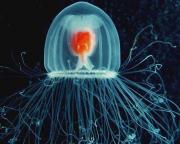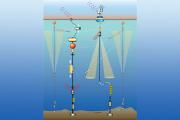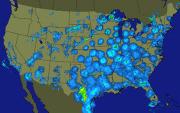Radio Program
Our regular Science and the SeaTM radio program presents marine science topics in an engaging two-minute story format. Our script writers gather ideas for the radio program from the University of Texas Marine Science Institute's researchers and from our very popular college class, Introduction to Oceanography, which we teach to hundreds of non-science majors at The University of Texas at Austin every year. Our radio programs are distributed at to commercial and public radio stations across the country.
Every year, large “dead zones” form in the Gulf of Mexico off the coasts of Texas and Louisiana. They form when river water loaded with fertilizer and other nutrients gushes into the Gulf. The nutrients spawn a massive “bloom” of microscopic organisms that use up much of the water’s oxygen. That kills fish and shellfish.
Stress can cut years from our lives. But for a tiny jellyfish-like organism, it’s just the opposite. Stress actually makes it age backwards — and eventually revert to its earliest stage of life. That provides a sort of immortality, as the organism produces a whole bunch of identical copies of itself.
The organism is known as Turritopsis. It was discovered in the 1880s in the Mediterranean Sea. Since then, it’s hitchhiked around the world in the ballast water of ships.
It’s hard to find a meat product these days that doesn’t have a soy-based equivalent — from burgers and chicken nuggets to bacon strips and chorizo. There aren’t a lot of soy substitutes for fish, though. But in the future it may not matter all that much, because many fish may be raised on a soy-based diet.
Astronomers have been building observatories on mountaintops for decades. Lifting their telescopes above most of Earth’s murky atmosphere provides a clearer view of the stars.
Marine scientists are starting to build observatories to see through the murkiness as well — packages of instruments to probe the unseen depths of the oceans. A network of them is taking shape now, with many of the instruments coming online in the next couple of years.
Every state has a long list of official icons. The official aircraft of New Mexico, for example, is the hot air balloon, while in Hawaii, the official sport is outrigger canoe paddling.
Many coastal states also have an official state shell. New York has the beautiful bay scallop, while Mississippi and Virginia have the un-beautiful but economically important oyster. And in Texas it’s the lightning whelk — a long, tapered shell that opens on the left side, not the right.
Fishermen are usually trying to find ways to get fish to take the bait. When it comes to sharks, though, they’re trying to find ways to get them to leave the bait alone. And one strategy seems to have the potential to keep the sharks away: using metals with special magnetic properties.
Many species of sharks are endangered. In part, that’s because they’re common “bycatch.” They’re not the intended catch, but they’ll take just about any bait that’s put in front of them, so they get caught anyway. Millions of sharks are taken as bycatch each year.
If you stand with outstretched arms, it likely means you’re about to give somebody a hug. But it could also mean that you’re showing them the length of a fathom — a unit that’s been used to measure the depth of the sea for centuries. It’s one of several measurements developed for maritime use that are still around today.
It sounds like the start of a bad joke: What do an airplane wing and shark skin have in common? But a recent study suggests there’s a serious answer. Both of them provide a type of “lift” — one to get an airplane off the ground, the other to increase the shark’s speed.
A shark’s skin is covered with tiny scales, called denticles. Grooves in these scales channel water around the shark, reducing drag and increasing its speed and agility.
Survival is all about change. Species that can adapt to changing conditions will live on, while those that can’t are doomed. That’s why a study released a couple of years ago may be good news for olive ridley sea turtles in the eastern Pacific Ocean. The study showed that the turtles go with the flow — they aren’t stuck in rigid patterns. In a world where the climate is changing in a hurry, that could help ensure the turtles’ survival.
Every spring, millions of visitors flock to the coasts of Texas and Louisiana. They gorge themselves for a few days before many of them head north — often all the way to Canada.
These visitors are birds — dozens of species that cross the Gulf of Mexico to reach their summer breeding grounds. And scientists and birdwatchers alike get early notice of the arrivals from radar — the same stations that are used to track the weather.





